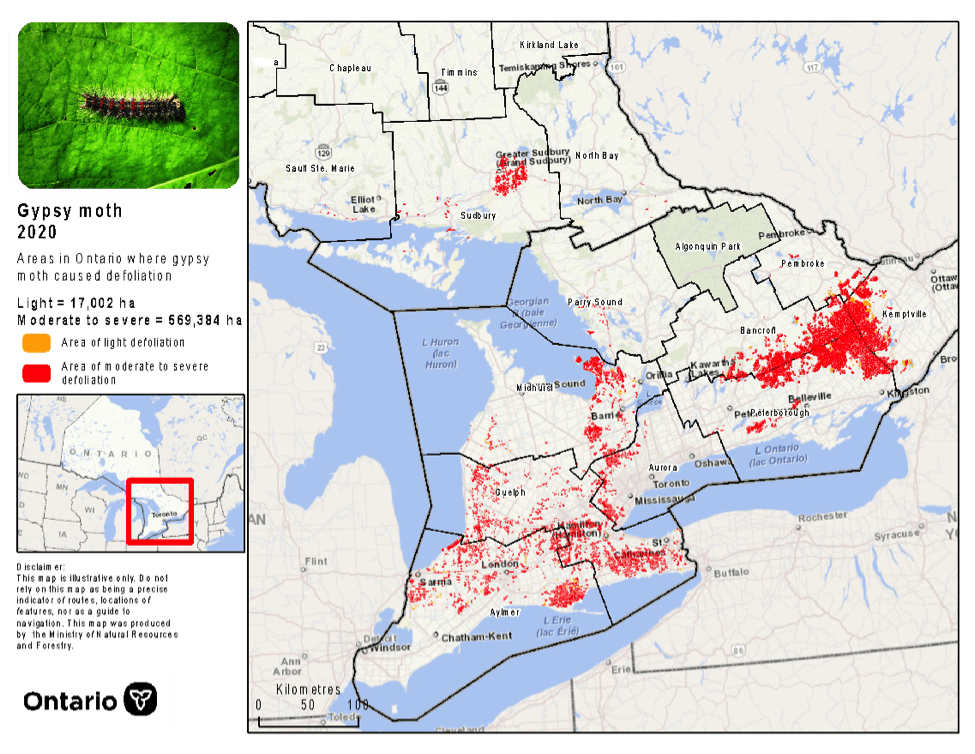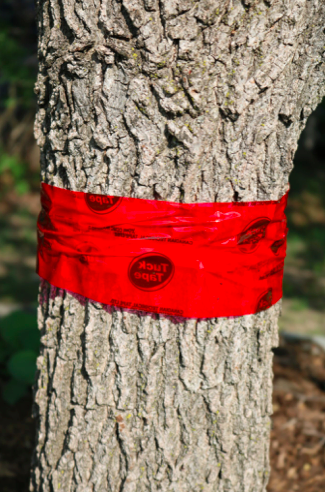Gypsy Moth
Gypsy Moth Information
Gypsy Moth Infestation
The gypsy moth is an invasive insect from Europe that was accidentally introduced in North America in the 1860s during an attempt to rear an alternative silk-producing insect. Gypsy moth caterpillars are 5 to 60 millimetres in length, dark and hairy, with five pairs of blue dots and six pairs of red dots on the back. They feed on a wide range of hardwood trees, as well as evergreen trees, but show a preference to oak trees (Quercus), birch (Betula) and aspen (Populus) in the north, to various hardwoods such as sugar maple (Acer saccharum) American beech (Fagus grandifolia) and softwoods such as eastern white pine (Pinus strobus), balsam fir (Abies) and Colorado blue spruce (Picea pungens) in Southern Ontario.
Eastern Ontario is experiencing a higher than normal level of European Gypsy Moth infestations. The first detection of gypsy moth in Ontario occurred in 1969; however, widespread defoliation did not occur until 1981. It is reported that the Peterborough District had the largest area of moderate to severe defoliation of 159,578 hectares in 2020, an increase from 409 hectares in 2019. This concentrated area of defoliation extended to Kemptville District and north to the Pembroke District (see map)
Map Source: https://www.ontario.ca/page/gypsy-moth
Characteristics and life cycle
● Overwinters in the egg stage often on the bark of trees.
● In spring, eggs hatch and larvae ascend the trees to feed on the new foliage.
● Initially, feeding occurs during the day, but as the caterpillars mature feeding occurs mainly at night — often this can delay the detection of infestations.
● Mature larvae are 50 mm long, dark coloured, hairy, with a double row of five pairs blue spots, followed by a double row of six pairs red spots, down the back.
● Feeding is completed in July.
● Male moths are light brown and slender-bodied, while females are white and heavy-bodied.
Here are several suggestions for homeowners for reducing the amount of European Gypsy Moth damage.
Note: these are suggestions only and results will vary based on the amount gypsy moth infestation.
1) Spray foliage with BTK (Bacillus thuringiensis) treatment purchased from a hardware store. Follow the instructions for mixing and apply to the foliage using a garden sprayer. BTK is sold out in many locations and may not be available until after the caterpillar stage, later in the summer.
2) Apply a burlap trap around the stem of the tree (see images) this will trap the caterpillar as they move up the tree into the canopy. The trap must be checked daily, place the trapped caterpillar in a container of soap and water. This will kill the caterpillars
Watch Video by the City of Toronto:
https://www.youtube.com/watch?v=oYf1F4-isRk
3) Spray the foliage with soap and water and manually remove as many of the caterpillars that you can safely reach. Again placing them in a container of soap and water. Wear gloves and wash your hands after touching the caterpillars, some people can react to caterpillar contact.
4) Place a sticky band around the tree to catch caterpillars as they move up the stem of the tree. In the image there is a ring of “tuck” tape used in house construction apply backwards. Replace the tape ring often, ensuring not to cut or damage the bark with scissors or knife.
NOTE: this must be checked daily to ensure birds have not been stuck to the tape ring.




